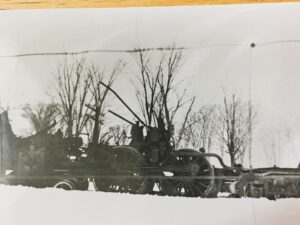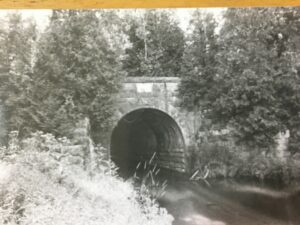Articles

Remains of the locomotive which exploded near the Syer Line bridge on the CPR line - 1943

Stone culvert for the Baxter Creek through the berm across Baxter Creeek valley south of the 4th Line
More Railway Stories
Millbrook, a sleepy village of some 250 people, was soon home to over 1,000 residents. Many men were employed at Millbrook Junction station, cutting and splitting wood to fuel the locomotives, overseeing stockyards of cattle and pigs heading to market, tending the storage buildings and grain warehouses, and loading or unloading freight onto the railcars. The station master’s crew also included the telegraphist and porters to assist passengers with their luggage. Horse drawn carriage drivers were busy taking passengers to and from the station. There were soon four hotels in the village as well as taverns supplying food and drink to visitors and villagers.
Produce from local farms could now be easily transported for sale to far-flung communities, down to Port Hope and along the Lakeshore to Toronto, Kingston and Montreal or even across Lake Ontario to the USA. Timber cut from the great forests of northern Peterborough and Victoria (now City of Kawartha Lakes) Counties was brought in spring log drives down the waterways to Peterborough and Beaverton, then by rail through Millbrook to Port Hope. Most went on by ship to Montreal, then overseas to Britain. In 1866, fifty million board feet of square timber went through Millbrook Junction and this local railway was among the most prosperous of Canada’s short railway lines. A dozen or more trains would pass through daily.
Manufactured goods that previously were very difficult to transport from the larger centres were now easily brought up to supply area shopkeepers for offer to the local population. A trip to Peterborough or Port Hope that once took most of a day was carried out in an hour. Toronto was now a few hours away instead of nearly a week of travel. Mail that once took a week or more to reach Toronto was now delivered in two days. Until 1934, students wishing to complete Grade 13 studies would commute daily to the Port Hope High School as the Millbrook school didn’t offer this final grade.
In 1884, a second rail line was opened through Cavan and North Monaghan townships. Locally this CPR line from Ottawa to Toronto went through Peterborough with whistle stops at Cavan Station east of the Cavan 4 Corners (formerly Cavanville) and at Dranoel outside Bethany. It is the only local railway line still in service, mostly carrying ore from the Nephton mines north of Havelock down to Toronto. It provided a direct route from Peterborough to Toronto and was a factor in the eventual decline in the status of Millbrook as a railway hub.
Working on the railroad was to some a romantic idea but in the days of steam it was one of the most dangerous occupations. Aside from the risks associated with working around any heavy machinery, especially in the days before safety regulations, there were the special risks associated with feeding wood or coal into the firebox while on a moving, swaying platform and also making sure there was sufficient water in the boiler to avoid overheating and explosion. In the late 1800s in the United States the annual fatality rate for railway workers was nearly one in one hundred; the rate for broken bones and amputations was higher.
On January 22, 1943, a westbound CPR passenger train from Peterborough to Toronto had passed the Tapley Quarter Line and was nearing where the Syer Line bridge crossed over the track when the boiler exploded; both the boiler and crew cab were blown through the telegraph and phone lines into a nearby pond. The engineer and fireman were both killed instantly, but thankfully the conductor and passengers were uninjured. Catastrophes like this were rare, but derailments and other accidents did occur from time to time. Following a derailment in 1923 at the back of the Lang farm on the Larmer Line “the engine was on its side and several cars were derailed, but fortunately no one was hurt. Quite a crowd of sightseers came through our fields to look at it.”
By the 1940s, the railway through Millbrook and Cavan was part of the CNR. Train travel and freight carriage was greatly decreased due to automobiles and truck transport. When the closure of the Port Hope to Millbrook line was threatened, a delegation from Millbrook went to Port Hope to meet CNR officials. According to Ken Fallis (who grew up on a farm on the Fallis Line), “when the meeting was over, one of the officials said ‘Well, you have just enough time to catch the last train to Millbrook’, but the delegates said, ’No, we have lots of time; we all drove down in our cars’. Well, that blew it for the village.”
The last train from Port Hope to Millbrook was on May 31st, 1951. The tracks were then removed. The tracks to Peterborough were removed later in the 1950s. The station at the corner of King and Main Streets was offered to the village for $1.00 but council rejected the offer and the station was torn down.
From This Green and Pleasant Land: Chronicles of Cavan Township: “The railroad is considered a luxury we can no longer afford despite the fact that travel by train is generally safe, pleasant and ecologically sound. Throughout their long history the two railways that ran through Cavan not only afforded a convenient and inexpensive means of travel, but also brought a welcome increase in trade and commerce to the Township”.
To find out more: the Millbrook & Historical Society has a number of publications available.

